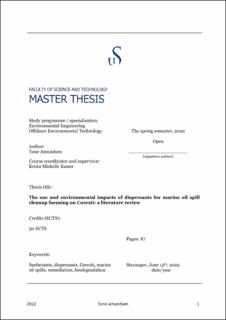| dc.description.abstract | Oil is still one of the major global energy sources as well as used for the production of products such as plastics and solvents. Due to the large global oil consumption, oil spills are difficult to avoid. The environmental impacts of these spills can be huge, especially in the marine environment. Oil floating on the ocean surface is harmful to marine life and it can be washed up to pollute coastal and shoreline areas damaging sensitive ecosystems. Therefore, it is very important to examine oil spill response strategies to reduce possible adverse consequences to protect the environment. There exist multiple oil spill response strategies all with advantages and drawbacks. Bioremediation plays an important role in oil spill cleanup and thus there has been a lot of research focusing on how bioremediation in marine environments can be improved. Biostimulation is stimulation of oil degrading through fertilizer addition. Oil dispersants such as Corexit can be applied to disperse oil into the water column. The aim is to stimulate removal by biodegradation by making the petroleum hydrocarbons more bioavailable to oil-degrading microorganisms, and to prevent oiling of shorelines and animals. A combination of conventional oil recovery methods along with dispersant is often preferrable. The methods used for cleanup are dependent on the location and nature of the spill. The use of dispersants often involves difficult choices, as they move the oil contamination into the water column which may harm the fish and benthic species etc. In addition, the chemical dispersants themselves may be toxic. This review examines dispersants and their efficiency on the enhancement of oil spill cleanup, toxicity and environmental impacts from dispersant use and dispersed oil, and possible alternatives to toxic dispersants. There are conflicting results on how dispersants enhance biodegradation, with the need for more research under different environmental conditions. Precautions should be taken during oil spill response as dispersants can be toxic to aquatic life like corals. Environmentally friendly dispersants can be applied such as food-grade-, biological- and biosurfactant-based dispersants, but aquatic species can still be harmed by the dispersed oil. Different environmental conditions with realistic and possibly declining concentrations of oil and dispersant should be used to test both the enhanced biodegradation by dispersants and on broad environmental impacts from the use of dispersants. More research is desirable on dispersants and the greener dispersants and their effects, to understand if and when they should be implemented. | |
